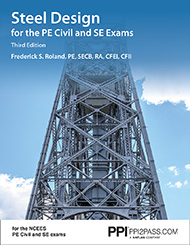Steel Design for the PE Civil and SE Exams (Includes Code Update PDF)
Available in Print or eTextbook
Fredrick S. Roland, PE's Steel Design for the PE Civil and SE Exams, Third Edition gives you a thorough overview of the concepts and methods you’ll need to solve steel analysis and design problems on the PE Civil Structural and SE exams. Sharpen your problem-solving skills, and assess your knowledge of how to apply important specifications with 37 exam-like, multiple-choice practice problems. Each problem is accompanied by a detailed, step-by-step solution showing both LRFD and ASD methods.
Prepare to Pass the Civil PE and Structural SE Exams
- Clear explanations of exam-adopted codes and standards
- Detailed examples illustrating a wide range of common situations
- Confidence-building practice problems
- Side-by-side LRFD and ASD solutions
- Thorough index and easy-to-use lists of tables, figures, problems, and nomenclature
Referenced Codes and Standards
- AASHTO LRFD 7th
- IBC 2015
- ASCE 7-10
- ACI 318-14
- AISC Steel
- NDS Wood 2015
- OSHA CFR 29 1910
- PCI 2010
- TMS 402/ ACI 530
Topics Covered:
- Allowable Strength Design (ASD)
- History and Development of Structural Steel
- Steel Beam Design
- Bolted Connections
- Load and Resistance Factor Design (LRFD)
- Steel Column Design
- Combined Stress Members
- Loads and Load Combinations
- Tension Member Design
- Composite Steel Members
- Plate Girders
- Welded Connections
- Flanges and Webs with Concentrated Loads
- One year of access
- Ability to download the entire eTextbook to multiple devices, so you can study even without internet access
- An auto sync feature across all your devices for a seamless experience on or offline
- Unique study tools such as highlighting in six different colors to tailor your study experience
- Features like read aloud for complete hands-free review
Sample PDFs
FAQs
Some states require a BS degree from an ABET-accredited engineering program to sit for the PE exam. Other states allow you to take the PE exam with a degree in engineering technology, physics, math, or chemistry—or without any degree—as long as you’ve met the required work experience. Check your state requirements to see if you can take the PE exam without an engineering degree.
Most states allow you to take the PE exam after passing your FE exam and gaining at least four years of post-college work experience. However, some states now allow examinees to sit for the PE exam before completing their work experience. Check your state requirements to see when you’re qualified to sit for the exam.
The PE exams are not considered easy to pass, but the exam will become easier if the content reflects topics that you're familiar with from your current line of work. Think about your career goals when considering the PE exam. Are you seeking a promotion in your current role? You should select the exam that best supports your current career. Are you trying to switch industries? Choose the exam that will set you up for success in your new field. Rather than seek out the easiest PE exam, select the one that will support your goals.
